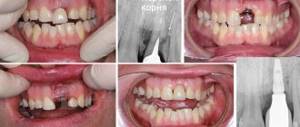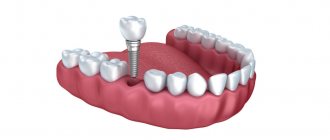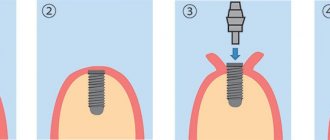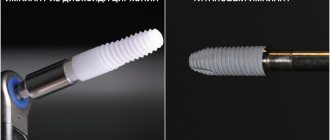Problem: a young man came to the Dial-Dent clinic with serious problems with his chewing teeth. The 2 lower teeth were severely damaged and could not be restored. The patient visited several clinics for consultations, and everywhere he was recommended to have these teeth removed.
Decision: chief physician of Dial-Dent S.V. Zukor recommends a modern method of restoring lost teeth - implantation.
The patient attended consultations at several dental centers and in all medical institutions the doctors agreed on one thing - the teeth cannot be restored and they must be removed. As can be seen on x-rays, the teeth are severely damaged and cannot be restored.
In one clinic, it was proposed to replace extracted teeth with a traditional bridge supported by crowns. This method of restoration involves grinding four healthy teeth adjacent to the missing ones (two on each side). The patient decided that this method was not suitable for him due to the violation of the integrity of healthy teeth. Another method offered to a patient in one of the Moscow dental clinics is a bridge-like prosthesis supported by inlays or micro-locks. This microinvasive method of prosthetics has many advantages over conventional prosthetics, however, the service life of such prostheses with micro-locks is 5-10 years. The patient wanted a longer service life and therefore turned to the Dial-Dent clinic, where, along with the two above methods, the patient was offered the most modern, microinvasive and reliable method of prosthetics with a long service life - dental implantation.
How did dental implants come about?
Actors who win an Oscar usually thank God and their parents. People who, with the help of implantation, regain their teeth and a comfortable lifestyle, should remember the Swedish professor Per-Ingvar Brånemark with a kind word. Quite by accident, he revolutionized dentistry.
In 1965, Branemark conducted research with a group of scientists. The professor implanted a titanium capsule into the rabbit and was very surprised when he could not remove it. So a happy accident helped to establish that titanium fuses with bone. Branemark decided to use the discovery in dental prosthetics.
The first lucky person with titanium implants is Gust Larsson. A simple carpenter, like Professor Branemark, went down in the history of implantology. Larsson, 34, had a completely toothless mouth. Not life, but torment: eating, talking, smiling - everything is difficult. The man himself found Branemark, having accidentally learned about his experiments. There was nothing left to risk, and Larsson became the first person in the world to receive implants. The patient lived with them for more than 40 years, until his death, proving the effectiveness and reliability of the new method.
The first experiment was successful, but the patient Brånemark was in no hurry to declare a revolution in dentistry. The scientist spoke publicly about his discovery 20 years later. The message caused a sensation! An accidental discovery turned the world of prosthetics upside down and returned a comfortable lifestyle to toothless patients.
What is dental implantation?
Dental implantation is the implantation of an artificial root into the upper or lower jaw. The implant is titanium and therefore completely biocompatible. This reliable crown support consists of:
- titanium screw (implanted into the jaw during surgery);
- abutment (attaches to the implant, resembles a ground tooth).
The answer to the question of whether to undergo dental implantation is clear: of course, yes. Today this is the most advanced method of prosthetics.
How much does dental implantation cost?
Today, this question is asked by every person who has dental problems and is interested in solving them. It is important to understand that, like any quality service, dental implantation is not cheap.
It is quite difficult to find information about the specific price of this procedure. In all dental clinics, only the cost of dental implantation surgery is charged for this procedure. Prices for the screws, crowns, abutments and other related products and services themselves represent a separate component of the entire dental implantation procedure. That is why it is most often not possible to give an independent answer to the question that interests many: how much does it cost to implant a tooth?
Photos before and after dental implantation
Surgery in the lateral part of the chewing teeth, in the area of the front teeth and with complete edentia.
Leading implant manufacturers
- Nobel Biocare (USA)
- Straumann (Switzerland)
- Astra Tech (Sweden)
- Alpha Bio (Israel)
- Ankylos (Germany)
- NDI Medical (Germany)
Dental implantation methods
A variety of dental implantation methods allow you to choose the ideal option for each patient.
One-stage
For those who do not want to wait a long time and who have no contraindications, dentists offer one-stage implantation with immediate loading. The peculiarity of the method is that the temporary prosthesis and implant are fixed in one step. Only a small incision is made in the gum. The temporary crown is replaced with a permanent one after 3 to 5 months. During this time, the dental implant finally takes root.
Two-stage
Two-stage implantation is time-tested. The operation takes longer, but the risk of complications is minimal - the doctor clearly sees what he is operating on by making an incision in the gum and folding back the flap. The abutment is installed six months after the implant has been implanted, the crown – a week after the abutment. This is a classic dental implantation, proposed by Professor Branemark.
One-step
Single-stage - implantation takes place simultaneously with tooth extraction. This is an ideal option for front teeth, when the aesthetic result comes to the fore. This technique is rarely used for chewing teeth.
An example of a one-stage implantation operation with immediate loading
Let's consider a specific example - a fracture of a front tooth at the root.
In such cases, the most reliable, durable and predictable form of prosthetics is the implantation of a missing tooth. The picture shows that the tooth was previously treated endodontically. The following treatment plan was proposed: tooth extraction followed by immediate implantation and installation of a temporary crown, installation of a permanent crown after the implant has healed. The patient approved of this plan. Let's look at the operation step by step.
Before the operation, the patient passed all the necessary tests, the oral cavity was sanitized and prepared for surgery.
In the photo, the root of the tooth has just been removed. Simultaneous implantation and installation of a temporary crown are planned.
It is very important to remove the root of the tooth as carefully as possible. Alveolar bone should be preserved as much as possible. For better implant healing, a platelet-rich clot was used.
Installation and adjustment of the plastic abutment. A plastic abutment with such a purpose that it should break before the load is transferred to the bone (in case of an emergency).
In the following photos, a temporary crown blank is installed on the implant. It will be polished, removed from the bite and temporarily glued to the adjacent teeth. This is done in order to reduce the load on the implant on which it is installed until it heals. The crown is also shown after completion of its aesthetic design.
Approximately one hour after tooth root removal, the patient resolves the aesthetic issue and does not experience discomfort during communication. He calmly waits until the implant takes root and it becomes possible to install a permanent crown.
Approximately 40 minutes passed from the moment the tooth was removed until the last photo was taken.
Stages of dental implantation
- Before implantation. Dental implantation, like any other operation, requires careful preparation. The result depends on this. The doctor must plan the implantation procedure as accurately as possible and identify all possible contraindications. At the first appointment, the implantologist asks general questions about your health. Referrals for tests and consultations with other specialists are provided if necessary. The oral cavity must be healthy - without caries and inflammation of soft tissues. A few days before surgery, you need to make an appointment for a cleaning.
- Anesthesia.
As a rule, local anesthesia is used for implantation. Modern drugs completely relieve the patient of pain and discomfort. If necessary, sedation or anesthesia is used.
- Implant installation.
If the dental implantation process proceeds without surprises, according to a pre-drawn plan, the operation will take 20 – 40 minutes. First, the doctor will install the implant, then check the degree of primary stabilization, and then decide whether to load it with a crown or not.
- Fixation of the crown.
A temporary crown is fixed if the dental implant is firmly anchored in the bone. In case of problems with the primary stabilization of the implant, only a gum former will be installed. A permanent crown can be placed after the artificial root has completely engrafted, after 3 to 5 months. An abutment will be fixed to the implant, and a permanent crown will be placed on it.
Dental implantation: the most frequently asked questions
Who should not get implants?
Of course, excluding obvious contraindications (infectious diseases, central nervous system, hypertonicity of the masticatory muscles, etc.), patient care for the implants is what is important to me. This has been written about in detail, but sometimes I view poor hygiene as disrespect for my work. Therefore, I really hope that patients will take this more seriously.
Dental implantation: the most frequently asked questions
How high is the risk of dental implant failure?
The success rate of dental implants varies depending on where in the jaw the implants are located, but generally, dental implants have a success rate of 98.5%. With proper care (I repeat), implants can last a lifetime.
Who is suitable for implantation?
In most cases, anyone who is healthy enough for tooth extraction or oral surgery can be considered for dental implants. Patients must have healthy gums and sufficient bone tissue so that the implant can be securely attached. Patients should also practice good oral hygiene and visit the dentist regularly.
Smokers, people suffering from uncontrolled chronic disorders such as diabetes or heart disease, or patients who have had radiation therapy to the head/neck area should be assessed on an individual basis . Usually, even if you have some kind of serious chronic disease, this is also not a refusal, but simply means that we will approach the process very individually. If you are considering implants, talk to your dentist to find out if they are right for you.
How does the implantation process occur?
The first step in the dental implant process is developing a personalized treatment plan. The plan is tailored to your specific needs and prepared by a team of professionals who are specially trained and experienced in the fields of surgery and prosthetics. This team approach ensures the highest quality treatment plan possible.
The implant, which is a small titanium rod, is then placed into the bone bed of the missing tooth. As the jawbone heals, it fuses with the titanium rod, firmly anchoring it in the jaw. The healing process can take from 6 to 12 weeks.
Once the implant is attached to the jawbone, a small connecting post called an abutment is attached to the post to securely hold the new tooth. To make a new tooth or teeth, your dentist takes impressions of your teeth and creates a model of your bite (which records all your teeth, their type and location). The new tooth or teeth are based on this model. The replacement tooth, called a crown, is then attached to the abutment.
Instead of one or more individual crowns, some patients may have attachments attached to the implant that hold and support the denture.
Next, the orthodontist selects the color of the new teeth that is closest to your natural teeth. Because the implant is anchored within the jawbone, dentures look, feel, and function just like your own natural teeth.
How soon should the temporary prosthesis be replaced?
The prosthesis must be changed according to the doctor’s recommendations: from 6 to 18 months.
Why can’t a ceramic prosthesis be placed immediately?
If you immediately install a permanent prosthesis, then the gums that do not shrink will simply lead to its deterioration and chips on the crowns. A temporary prosthesis is an obligatory part of implantation, during which all the necessary processes take place so that in the future your permanent prosthesis will last as long as possible.
What kind of implants are best to place?
You need to choose premium ones, and not because when I say this, I am pursuing profit. Fly-by-night companies cannot provide the quality and service that manufacturers such as Straumann, Nobel, Megagen, etc. guarantee.
It’s also a matter of the quality of the material, because premium lines do not contain other impurities in the alloy, so the engraftment is the best. Also, the surface of the implant is cleaner, which also affects the fusion with biological tissues.
How long does the implantation procedure take?
Installation of one implant takes no more than 20 minutes. The artificial root takes from 3 to 5 months to take root. The entire period of treatment and recovery may take a year. The time frame is different for everyone, depending on the number of implants - some need to have 6 or more teeth implanted, others only need one. The duration of the process is affected by the volume and quality of bone tissue. The jaws also have peculiarities. On the bottom, the dental implant fuses with the bone faster, in 3–4 months, because the bone is denser. In the upper jaw, its volume is smaller, because of this the period of osseointegration is longer, 5 – 6 months. The end of implantation is the fixation of permanent crowns. Occurs after the implant has completely healed.
Types of implant-supported prostheses
Implant-supported dentures are securely attached to the jaw. There are several types of orthopedic structures. Your doctor will help you choose the right one.
- Fixed dentures.
Crowns are installed on the implants; in appearance, such teeth are no different from real ones. The method is suitable for the loss of one tooth or several in a row. - Bridge-like fixed prostheses.
A bridge instead of single crowns is an economical option for the patient. Used for an area with several missing teeth in a row. Minimum – 2 implants. - Removable dentures.
As a rule, they are used for complete edentia. Installation on an implant ensures that the prosthesis will not fall out of the mouth due to reliable fixation. At the same time, it is easy to remove it by unfastening the clasps. The patient chews easily, diction does not change, and there is no gag reflex. - Conditionally removable dentures.
They are very similar to removable dentures, but they cannot be removed without the help of a doctor. The prosthesis is secured not with locks, but with screws. The most common installation methods differ in the number of implants on which the structure is attached. There can be a minimum of three, four and six titanium roots.
Reiter
Today, everyone can get a truly beautiful and charming smile thanks to the rapid development of modern dentistry. Those medical advances that seemed like something fantastic just thirty years ago can today help many people find a “Hollywood” smile and get rid of long-standing complexes and fears about their appearance. As you probably already guessed, this article will focus on dental implantation, which allows you to fully restore lost teeth by replacing them with realistic, high-quality and highly functional implants.
In addition, here you can see what dental implants actually look like; the photos will help you fully with this.
What is dental implantation?
Dental implantation is a dental procedure that allows a person to restore the functionality and attractive appearance of their jaws by installing special implants. Indications for such a procedure can be very different, including the absence of one or more teeth in the oral cavity, poor condition of dental tissues that cannot be treated (in this case, the diseased teeth are first removed and dentures are placed in their place).
Many patients who plan to seek this procedure are interested in what exactly dental implants look like. As for the appearance of dental implants, the photos presented on our website will help you understand what they look like in real life.
What is a dental implant?
Dental implants by their design consist of several parts, namely:
- 1. Implant. This is the name given to a special screw made of high-quality titanium alloy. During a dental implant procedure, this screw is surgically attached to a person's jaw;
- 2. Abutment. An abutment is a special part of a dental implant that acts as a connecting link between the implant (screw) and the prosthesis itself;
- 3. Denture or dental crown. The prosthesis is the main part of the entire implant that is visible to other people. It is involved in the process of chewing food and is made from special materials, thanks to which it has all the qualities of ideal teeth, namely excellent appearance, strength, reliability and durability.
This description belongs to the category of so-called collapsible implants. This in turn means that each individual part of the implant can be separated from the other if necessary. In addition, they are installed gradually in several stages. It is worth noting that today you can also find non-separable dental implants, a photo of which you can also find on our website. Their peculiarity lies in the fact that the implant itself, that is, a metal screw mounted into the jaw bone tissue, and the abutment are one whole product made of the same material.
If we talk about what the denture itself is, it can be very different. This can be a permanent artificial prosthesis made of high-quality and durable material, or a removable crown, bridge or something else. The most suitable type of implant, as well as the denture itself, is selected by the dentist, taking into account the individual characteristics of the patient, as well as his personal wishes.
How exactly are dental implants installed?
In most cases, dental implants, photos of which you can see on our website, are installed in three to four successive stages. If we talk about how long the entire procedure of dental prosthetics takes, it should be noted that its timing can be different and depends on a huge number of factors. The individual situation of each patient is taken into account, for example, how quickly and well the body accepts the implant and other factors.
In general, implants are installed in several stages, namely:
- 1. Stage one. Assessment of the body's condition. The dentist conducts a comprehensive examination of the patient, while studying his state of health. At this stage, the specialist who will install the implant checks whether the patient has any contraindications to this procedure. It is worth noting that contraindications can be very different. The most common of them include heart disease, diabetes, tuberculosis, hypertension, severe forms of periodontitis and much more;
- 2. Stage two. Implant installation. The dental surgeon installs a special titanium screw, which is the support of the entire structure;
- 3. Stage three. Installation of abutment. Typically this stage begins a few months after the previous stage. The abutment will serve as a connecting element between the screw and the crown of the new tooth;
- 4. Stage four. Creation of a prosthesis and its installation on an abutment. The denture is created in such a way that it looks harmonious with other teeth or implants that the patient has.
If you are interested in what modern and high-quality dental implants look like, the photos presented on our website will help you with this.
Care instructions
Implantation of 1 tooth usually does not affect the patient’s lifestyle. Installation of several implants, and even with bone grafting, may cause slight swelling. The problem disappears 2 to 4 days after surgery. In order for the process of implant engraftment and restoration to be successful, you should listen to the doctor’s recommendations:
- At first, avoid too hot/cold food;
- chew on the side where there was no surgery;
- brush your teeth carefully;
- bathhouse, sauna – postpone;
- don't get too cold.
After bone tissue augmentation – sinus lift – there are more restrictions:
- do not fly on an airplane;
- don't dive;
- don't blow your nose;
- sneezing and coughing with your mouth open;
- do not drink through a straw;
After 3–4 weeks, restrictions are lifted. Aftercare after dental implants is no different from oral hygiene with your own teeth. It is also necessary to thoroughly brush your teeth, rinse your mouth after eating, and undergo hygienic cleaning every six months. Experts recommend adding an irrigator to a regular brush and paste. The device is especially useful after complex implantation with the restoration of a large number of teeth.
Complex cases
In fact, in my work I often have to approach problem solving quite creatively. Sometimes the cases are so unusual that you don’t even believe in a good result. But I cannot leave the patient alone with this problem, realizing that no one may take on this work. Moreover, I have a team with whom we take on these cases. We try, and the most incredible thing is that we succeed.
I'll tell you one case. The patient came to me from a distant corner of Russia with a very difficult and neglected situation. The patient experienced a colossal loss of bone tissue. The orthopedic dentist and I understood that people no longer expect high aesthetics, but still really want to live a full life.
We convened a consultation, I remember asking the opinion of many of my colleagues - the majority gave quite reasonable advice to abandon this case and not risk their reputation. But I still took it. Of course, I assessed all the risks, and we discussed them with the patient.
The decision was made rather unconventionally - we decided to reduce the total number of implants and do complex All-on-5 implantation instead of All-on-6. In the end, everything turned out even better than we expected.
Another story of progress. 8 years ago I performed basal implantation on a patient. Even then the bone was very thin, and I won’t say that it came as a surprise to me when the patient again approached me with a request for reimplantation. After studying 3D tomography, it turned out that the implants had fallen into the sinus; as a result, our team of doctors decided to perform All-on-4 zygomatic implantation. Fortunately, the patient was lucky here too and everything healed perfectly.
However, I realized that the new knowledge that was gained through many courses, practices, and seminars provided the most important thing - the opportunity to apply non-standard solutions and help people leave with QUALITY work done.
Indications and contraindications for dental implantation
Dental implantation can be used in cases where one, several or all teeth are missing. Many are afraid of this technique, considering it risky. The list of contraindications is not as long as it might seem.
Absolute contraindications:
- age (the jawbone is fully formed only by 17–22 years);
- blood clotting problems;
- oncological diseases;
- osteoporosis;
- recovery after myocardial infarction;
- cardiovascular diseases in the acute stage;
- diabetes mellitus in the stage of decompensation;
- connective tissue diseases;
- alcoholism;
- diseases of the skeletal system;
- disorders of the nervous system;
- chronic liver and kidney failure;
Relative contraindications:
- bearing and feeding a child;
- active smoking;
- abnormal bite (requires adjustment);
- acute periodontitis (requires treatment);
- tartar (requires removal);
- diabetes mellitus in the compensation stage;
- bruxism.
Pregnancy and breastfeeding are relative contraindications to dental implantation for women. But doctors still recommend postponing the procedure. Women expecting a child are generally not recommended to undergo surgical interventions without special indications, especially in the first trimester, when the formation of the baby’s vital organs occurs. Implantation is performed using local anesthesia, after the operation painkillers and anti-inflammatory drugs are prescribed, and X-rays are taken before implantation. All this is extremely undesirable for pregnant women. During pregnancy, immunity is reduced, and recovery after implantation may be delayed. Breastfeeding is another reason to postpone implantation: medications are prohibited, and stress may cause milk to disappear.
Feelings during surgery
Installing 1 implant feels like removing one tooth. Doctors make this comparison when patients ask them what to expect from dental implant surgery. In most cases, artificial roots are implanted under local anesthesia. But patients who begin to worry even before the operation begin are sedated with local anesthesia. This is not a painkiller, but a sedative, relieves stress, anxiety, and increases the pain threshold. The patient remains conscious, but in a state close to deep sleep. Painful impulses are blocked, fear and anxiety go away, while the contact between the patient and the doctor is maintained. After sedation, there are no memories of the operation, neither good nor bad.
Severe fear, particularly complex treatment, complex dental implantation - in these cases the patient can be put to sleep using anesthesia. He falls asleep with a toothless mouth and wakes up with teeth.
Practice and more practice
Most patients understand that a good surgeon is only one who practices almost daily. Moreover, the result, attitude, and feedback are important. I am not the doctor who is fed up with the patient's fear. Knowing all the details of the patient’s upcoming operation and rehabilitation, I best understand all the patient’s fears and try to treat them with respect. Sometimes I am truly amazed at the bravery of these people.
But the point is different - today I understand that the experience and knowledge gained simply need to be shared with colleagues. Therefore, since 2019, my colleague, orthopedist Anton Pavlovich Dobritsky and I have been giving seminars throughout the Republic of Belarus. This is important not only for fellow doctors from other cities, but also for my personal growth. After all, after the seminars, doctors ask different questions, express their opinions, and I can already look at this or that case from a different point of view.
In any case, when choosing an implantologist, a patient should rely not only on a big name, but also on the doctor’s actual practice. And do not confuse information on the Internet with marketing and advertising. Try to study the real activities of the doctor. I also consider it absolutely normal for a patient to contact other implant surgeons with a preliminary treatment plan. A second opinion is great. But personally, I am sticking to the course I have set. Not because I don't respect my colleagues. I’m just ready to take on only things for which I can then be responsible.
All-On-4 Implantation
Risks of implantation
The survival rate of implants today is a record 99%. But no one will ever give 100%; it is impossible to eliminate all risks. Someone will definitely fall into this 1%. Complications during implantation are very rare, but they do occur. During implantation of an artificial root, the following may happen:
- Inflammation of the tissue around the implant (peri-implantitis).
The doctor will rule out the cause of the inflammation and treat the root with special solutions. In case of relapse, the implant will have to be removed and the bone tissue will have to be restored. - Implant rejection.
It happens extremely rarely. The artificial root is removed. - The implant is unscrewed together with the plug.
This may occur during abutment placement. In the absence of inflammation, the titanium root is put in place. - The implant is pushed into the maxillary sinus.
In such cases, only removal of the titanium root will help. - Exposing the upper part of the implant.
A fairly common complication that affects aesthetics more than health.
Make an appointment
right now!
Akhmedkhanov Said Rashidovich
Surgeon, Therapist, Orthopedist, Hygienist, Implantologist










